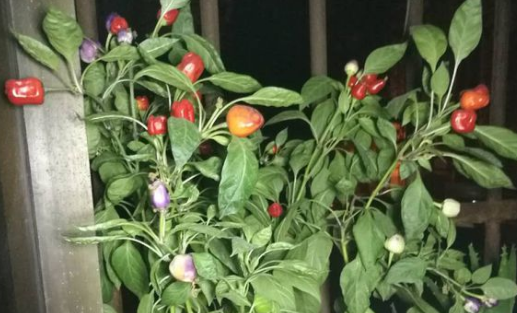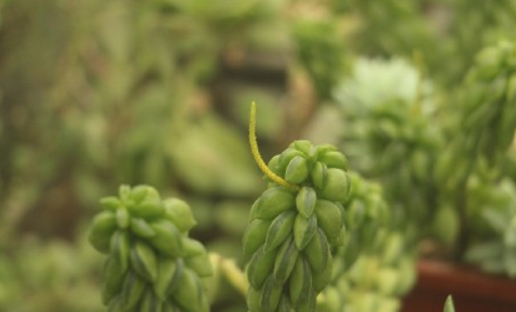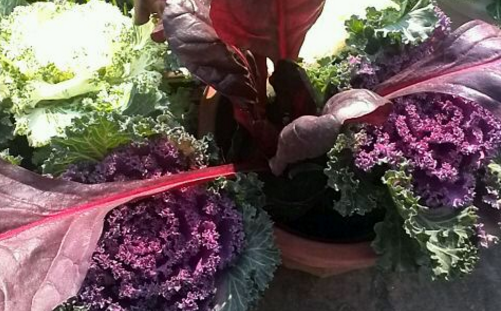What are the varieties of colorful pepper in Solanaceae? How to sow and reproduce? What is the effect and effect?
Colorful pepper, also known as colorful pepper, it is also known as Chaotian pepper, colorful pepper and so on, so what are the varieties of colorful pepper? How to sow and reproduce? What is the effect and effect? It is understood that colorful pepper is a variety of pepper, is a perennial herb, the plant type is not high. Colorful pepper often blossoms on the branches, the flowers are small, but after flowering will bear fruit, the fruit is its main ornamental part.

What are the varieties of colorful peppers?
1. Chaotian class
The fruit is upward, round, heart-shaped or conical in shape, and the fruit is solitary in leaf axils. The fruit color changes from white to red, or from white or yellow to blue and purple. In addition to this, there is also a single color, and there are also kinds of green, white, yellow or red.
2. Clustered class
Also known as bergamot pepper, most of the fruit of this variety is concentrated at the end of the branch, mostly in the shape of a long heart or cone, and the color is mostly white or green to red.
3. Drooping class
The fruit grows in the axils of the leaves. The fruit is drooping, mostly in irregular cones. Depending on the variety, the body size varies, and the fruit color changes from green to red or yellow.
4. Lanterns
The fruit grows in the axils of the leaves. Fruit drooping, mostly truncated cone-shaped square, but also multi-angled shape, smooth corners, fruit color generally from green to white or red or yellow or black-purple and so on. And there is a distinction between long, short, high and short.
In addition, it can also be divided according to the height, medium and short of the plant type, the height can be up to 1 meter, while the dwarf plant type is only 10 centimeters.
Second, how to sow and reproduce?
1. Sowing and propagation of colorful pepper
The sowing time is generally chosen at the end of spring, when the indoor or outdoor weather is sunny and warm, the optimum temperature for germination is between 25-30 ℃, and it can germinate about 5-10 days after sowing. In the seedling stage, liquid fertilizer should be applied 1-2 times, and then transplanted and cultivated when the height of the plant reaches 8-10 cm.
In the greenhouse environment, generally sowing in late March, sowing can be indoor pot sowing or seedling bed sowing, wait until the true leaves grow 3-4 pieces for transplant. In the middle and last ten days of June, the open field was planted. If you want to watch as a potted plant, you can plant it in a flowerpot with a diameter of about 20 cm in early June, and you can begin to bear fruit in August.
2. Seedling and sowing of colorful pepper
The suitable temperature for the germination of colorful pepper plants needs to be above 25 ℃. If the plastic film shed is used for heat preservation, it can be cultivated in four seasons, and the sowing can be seeded in seedbed or pot.
Choose fertile and loose soil with good drainage and permeability. The soil needs to be screened and disinfected by exposure, fumigation, high temperature treatment and other methods to kill bacteria and eggs.
Before sowing, you need to spray enough water on the seedbed, wait for the water to permeate, and then spread the seeds evenly into the soil, then cover them with fine soil, with a thickness of about 1 centimeter, and finally spray water again. When the temperature is low, you need to build a thin film.
Wait until the buds are unearthed, pour human feces and urine 1-2 times or sprinkle 0.1% urea solution appropriately, remember to spray water to wash away the fat liquid left on the leaves, avoid burning the young leaves, and wait until the leaves reach 5-6 true leaves, you can transplant.
Third, what is the effect and function?
1. The ornamental value of colorful pepper.
Colorful pepper is an excellent ornamental fruit pot, the fruit of a variety of colors, there are red, purple, white, green, yellow five colors, full of luster, lively and beautiful. And the fruit is small, each facing up, embellished in the leaves, appears exquisite lovely, lovable.
2. The nutritional value of colorful pepper.
Colorful pepper is rich in vitamins A, B, C and β-carotene. Sugars, fiber, calcium, phosphorus and iron can enhance immunity, resist the destruction of free radicals and protect eyesight. Regular consumption of colorful pepper can not only nourish the hair root, but also strengthen the nails, for the skin, it also has the function of activating cell tissue, can promote metabolism, make the skin smooth and delicate, white and bright, and has a certain cosmetic effect, in addition, it can prevent the fragile bleeding of microvessels, retina, cerebral vessels and gingival bleeding, and it is also a more suitable food for patients with diabetes.
3. The medicinal value of colorful pepper.
Colorful pepper has the functions of warming the stomach, dispelling cold and removing dampness. Oral administration can be used to treat stomach cold and fullness, indigestion, loss of appetite, wind cold and cold, etc.; external use can promote the blood circulation of the skin, and has a good effect on the treatment of chilblain and rheumatic pain.
Time: 2019-03-16 Click:
- Prev

Douban green is axe leaf pepper grass family culture methods and matters needing attention? What if the leaves fall off? What about the rotten stem?
The axe leaf pepper grass is the pepper grass belongs to the pepper grass succulent plant, the spring and autumn is its growth period, then the axe leaf pepper grass family breeding method and the matters needing attention? What if the leaves fall off? What about the rotten stem? It is understood that the axe leaf pepper prairie comes from Peru and needs a sunny, cool and dry environment. It is resistant to semi-shade and is afraid of waterlogging.
- Next

What varieties are there in Cruciferae collard greens? Can I cut it? Can I eat it?
Kale is called peony, cabbage, green kale, so what are the varieties of kale? Can I cut it? Can I eat it? According to information, kale likes cold climate, cold tolerance is relatively strong, so in the cold winter, people can also see it growing. Kale can endure shade.
Related
- Fuxing push coffee new agricultural production and marketing class: lack of small-scale processing plants
- Jujube rice field leisure farm deep ploughing Yilan for five years to create a space for organic food and play
- Nongyu Farm-A trial of organic papaya for brave women with advanced technology
- Four points for attention in the prevention and control of diseases and insect pests of edible fungi
- How to add nutrient solution to Edible Fungi
- Is there any good way to control edible fungus mites?
- Open Inoculation Technology of Edible Fungi
- Is there any clever way to use fertilizer for edible fungus in winter?
- What agents are used to kill the pathogens of edible fungi in the mushroom shed?
- Rapid drying of Edible Fungi

